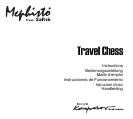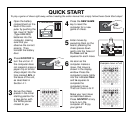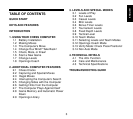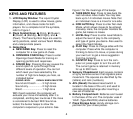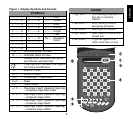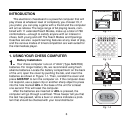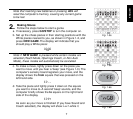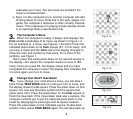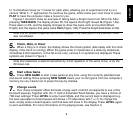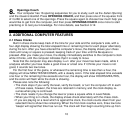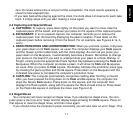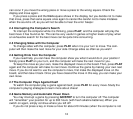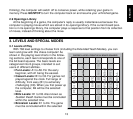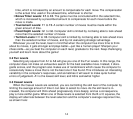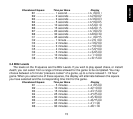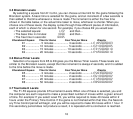
9
ENGLISH
to 14 individual moves (or 7 moves for each side), allowing you to experiment and try out
various “What if...?” approaches. To continue the game, either make your next move or press
PLAY to have the computer make a move for you.
Figures 1-6a and b show an example of taking back a Knight move from G8 to F6. After
pressing TAKE BACK, the display shows F6, the square the Knight moved to (Figure 1-6a).
Press down on F6, and the display changes to show the piece color and symbol (Black
Knight) and the square that piece came from (Figure 1-6b). Press the Knight back down on G8.
Note that en passant captures cannot be replayed if the take back of the previous move
was not allowed.
Check, Mate, or Draw!
5. When a King is in check, the display shows the check symbol (alternately with the clock
display, if the clock is running). When the game ends in checkmate or a draw (by stalemate,
immediate 3-fold repetition, or the 50-move rule), various End symbols are displayed. These
symbols are shown in Figure 1.
Note that stalemate is determined either by 3-fold repetition of the same move, or by the
50-move rule.
Start a New Game
6. Press NEW GAME to start a new game at any time, using the currently selected level
and sound setting. Since pressing NEW GAME clears your current game from the computer’s
memory, be very careful not to press this key by mistake.
Change Levels
7. Your chess computer offers 64 levels of play, each of which corresponds to one of the
64 board squares. Together with the 11 built-in Extended Teach Modes, you have a choice of
768 level settings! Press LEVEL to enter Level Mode, and the current level is displayed (e.g.,
the level equivalent to board square A3 shows L:A3 alternately with Fun3). To change the
level, simply press a board square, and that level will show in the display. Press LEVEL again
to exit Level Mode. For more information on the playing levels, see Section 3.



